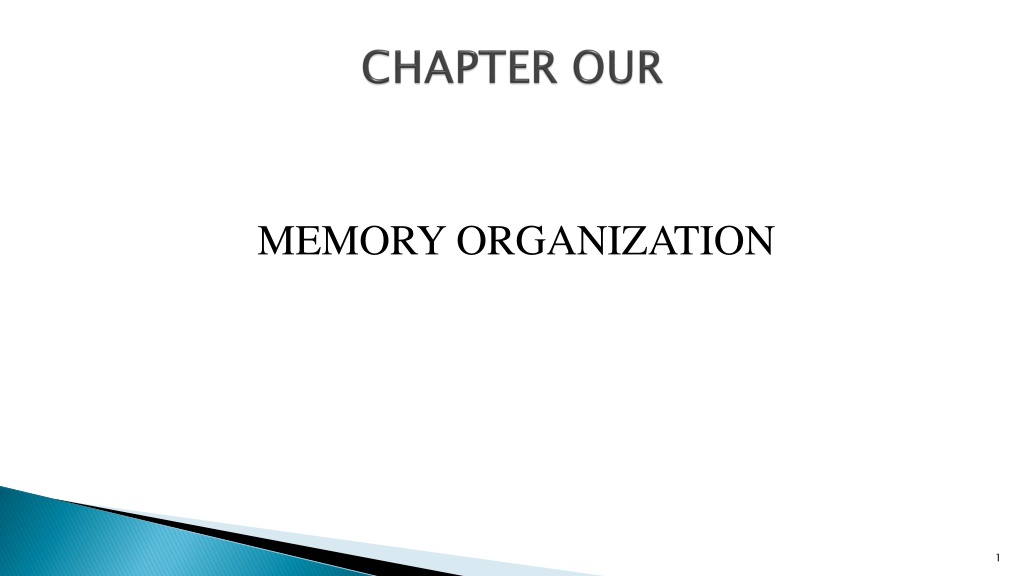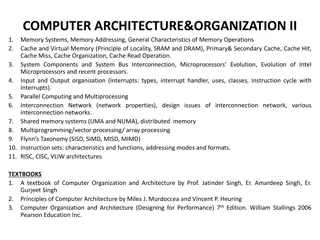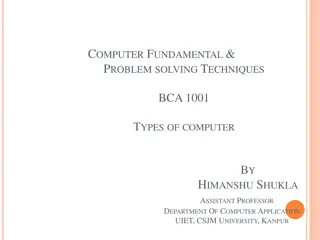Understanding Memory Organization in Computers
The memory unit is crucial in any digital computer for storing programs and data. It comprises main memory, auxiliary memory, and cache memory, each serving different roles in data storage and retrieval. Main memory directly communicates with the CPU, while cache memory enhances processing speed by storing frequently accessed data. Memory hierarchy, including volatile (RAM) and non-volatile (ROM) memory, plays a key role in optimizing data access. Efficient data transfers between memory, processor, and disk are vital for computer system performance, influenced by factors like memory latency and bandwidth.
Download Presentation

Please find below an Image/Link to download the presentation.
The content on the website is provided AS IS for your information and personal use only. It may not be sold, licensed, or shared on other websites without obtaining consent from the author. Download presentation by click this link. If you encounter any issues during the download, it is possible that the publisher has removed the file from their server.
E N D
Presentation Transcript
The memory unit is an essential component in any digital computer since it is needed for storing programs and data. Not all accumulated information is needed by the CPU at the same time. Therefore, it is more economical to use low-cost storage devices to serve as a backup for storing the information that is not currently used by CPU A memory unit is the collection of storage units or devices together. The memory unit stores the binary information in the form of bits. Generally, memory/storage is classified into 2 categories: Volatile Memory(RAM): This loses its data, when power is switched off. Non-Volatile Memory(ROM): This is a permanent storage and does not lose any data when power is switched off 2 2
The memory unit that directly communicate with CPU is called the main memory Devices that provide backup storage are called auxiliary memory The memory hierarchy system consists of all storage devices employed in a computer system from the slow by high-capacity auxiliary memory to a relatively faster main memory, to an even smaller and faster cache memory 3 3
o The main memory occupies a central position by being able to communicate directly with the CPU and with auxiliary memory devices through an I/O processor o The cache memory is used to store program data which is currently being executed in the CPU. o A special very-high-speed memory called cache is used to increase the speed of processing by making current programs and data available to the CPU at a rapid rate 4 4
CPU logic is usually faster than main memory access time, with the result that processing speed is limited primarily by the speed of main memory The cache is used for storing segments of programs currently being executed in the CPU and temporary data frequently needed in the present computations. The typical access time ratio between cache and main memory is about 1to7 Auxiliary memory access time is usually 1000 times less than that of main memory. TN = TA +n/R Where TN Average time to read or write N bits TA Average access time n Number of bits R Transfer rate, in bits per second (bps) TN = TA +n/R 5 5
The speed and efficiency of data transfers among memory, processor, and disk have a large impact on the performance of a computer system. Memory latency the amount of time it takes to transfer a word of data to or from the memory. Memory bandwidth the number of bits or bytes that can be transferred in one second. It is used to measure how much time is needed to transfer an entire block of data. Bandwidth is not determined solely by memory. It is the product of the rate at which data are transferred (and accessed) and the width of the data bus. 7 7
Each memory type, is a collection of numerous memory locations. To access data from any memory, first it must be located and then the data is read from the memory location. Following are the methods to access information from memory locations: 1. Random Access: Main memories are random access memories, in which each memory location has a unique address. Using this unique address any memory location can be reached in the same amount of time in any order. 2. Sequential Access: This methods allows memory access in a sequence or in order. 3. Direct Access: In this mode, information is stored in tracks, with each track having a separate read/write head. 8
Most of the main memory in a general purpose computer is made up of RAM integrated circuits chips, but a portion of the memory may be constructed with ROM chips Main memory is made up of RAM and ROM, with RAM integrated circuit chips holing the major share RAM: Random Access Memory Static RAM (SRAM) oEach cell stores bit with a six-transistor circuit. oRetains value indefinitely, as long as it is kept powered. oRelatively insensitive to disturbances such as electrical noise. oFaster and more expensive than DRAM. Dynamic RAM (DRAM) oEach cell stores bit with a capacitor and transistor. oValue must be refreshed every 10-100 ms. oSensitive to disturbances. oSlower and cheaper than SRAM. 9 9
Tran. per bit time Access Persist? Sensitive? Cost Applications SRAM 6 1X Yes No 100x cache memories DRAM 1 10X No Yes 1X Main memories, frame buffers 10 10
In random-access memory(RAM) the memory cells can be accessed for information transfer from any desired random location. That is, the process of locating a word in memory is the same and requires an equal amount of time no matter where the cells are located physically in memory. Communication between a memory and its environment is achieved through data input and output lines, address selection lines, and control lines that specify the direction of transfer. 11 11
The n data input lines provide the information to be stored in memory, and the n data output lines supply the information coming out of particular word chosen among the 2 available inside the memory. The two control inputs specify the direction of transfer desired 12
Write and Read Operations The two operations that a random access memory can perform are the write and read operations. The write signal specifies a transfer-in operation and the read signal specifies a transfer-out operation. On accepting one of these control signals. The internal circuits inside the memory provide the desired function. The steps that must be taken for the purpose of transferring a new word to be stored into memory are as follows: 1. Apply the binary address of the desired word into the address lines. 2. Apply the data bits that must be stored in memory into the data input lines. 3. Activate the write input. 13
The memory unit will then take the bits presently available in the input data lines and store them in the specified by the address lines. The steps that must be taken for the purpose of transferring a stored word out of memory are as follows: 1. Apply the binary address of the desired word into the address lines. 2. Activate the read input. The memory unit will then take the bits from the word that has been selected by the address and apply them into the output data lines. The content of the selected word does not change after reading. 14
ROM is used for storing programs that are PERMENTLY resident in the computer and for tables of constants that do not change in value once the production of the computer is completed The ROM portion of main memory is needed for storing an initial program called bootstrap loader, witch is to start the computer software operating when power is turned off As the name implies, a read-only memory(ROM) is a memory unit that performs the read operation only; it does not have a write capability. This implies that the binary information stored in a ROM is made permanent during the hardware production of the unit and cannot be altered by writing different programs. 15
The binary information to be stored, specified by the designer, is then embedded in the unit to form the required interconnection pattern. ROMs come with special internal electronic fuses that can be programmed for a specific configuration. Once the pattern is established, it stays within the unit even when power is turned off and on again. An m x n ROM is an array of binary cells organized into m words of n bits each. As shown in the block diagram below, a ROM has k address input lines to select one of 2 = m words of memory, and n input lines, one for each bit of the word. An integrated circuit ROM may also have one or more enable inputs for expanding a number of packages into a ROM with larger capacity. 16
The required paths in a ROM may be programmed in three different ways. 1. The first, mask programming, is done by the semiconductor company during the last fabrication process of the unit. This procedure is costly because the vendor charges the customer a special fee for custom masking the particular ROM. For this reason, mask programming is economical only if a large quantity of the same ROM configuration is to be ordered. 2. For small quantities it is more economical to use a second type of ROM called a Programmable Read Only Memory(PROM). The hardware procedure for programming ROMs or PROMs is irreversible, and once programmed, the fixed pattern is permanent and cannot be altered. Once a bit pattern has been established, the unit must be discarded if the bit pattern is to be changed. 18
3. A third type of ROM available is called Erasable PROM or EPROM. The EPROM can be restructured to the initial value even though its fuses have been blown previously. Certain PROMs can be erased with electrical signals instead of ultraviolet light. These PROMs are called Electrically Erasable PROM or EEPROM. Flash memory is a form of EEPROM in which a block of bytes can be erased in a very short duration. Example applications of EEPROM devices are: o Storing current time and date in a machine. o Storing port statuses. Example of Flash memory device applications are: Storing messages in a mobile phone. Storing photographs in a digital camera. 19
If the active portions of the program and data are placed in a fast small memory, the average memory access time can be reduced. Thus reducing the total execution time of the program Such a fast small memory is referred to as cachememory The cache is the fastest component in the memory hierarchy and approaches the speed of CPU component Analysis of a large number of typical programs has shown that the references to memory at any given interval of time tend to be confined within a few localized areas in memory. This phenomenon is known as the property of locality of reference. When a program loop is executed, the CPU repeatedly refers to the set of instructions in memory that constitute the loop. 20 20
Every time a given subroutine is called, their sets of instructions are fetched from memory. Thus loops and subroutines tend to localize the references to memory for fetching instructions. To a lesser degree, memory references to data also tend to be localized. Table lookup procedures repeatedly refer to that portion in memory where the table is stored. Iterative procedures refer to common memory locations and array of numbers are confined within a local portion of memory. If the active portions of the program and data are placed in a fast small memory, the average memory access time can be reduced, thus reducing the total execution time of the program. Such a fast small memory is referred to as a cache memory. It is placed between the CPU and main memory as illustrated in fig below 21
When CPU needs to access memory, the cache is examined If the word is found in the cache, it is read from the fast memory If the word addressed by the CPU is not found in the cache, the main memory is accessed to read the word The performance of cache memory is frequently measured in terms of a quantity called hit ratio When the CPU refers to memory and finds the word in cache, it is said to produce a hit Otherwise, it is a miss Hit ratio = hit / (hit + miss) 23
The basic characteristic of cache memory is its fast access time, Therefore, very little or no time must be wasted when searching the words in the cache The transformation of data from main memory to cache memory is referred to as a mapping process. Three types of mapping procedures are of practical interest when considering the organization of cache memory: 1. Direct mapping 2. Associative mapping 3. Set-associative mapping 24
The simplest technique, known as direct mapping, maps each block of main memory into only one possible cache line. The mapping is expressed as: i =j modulo m Where i= cache line number. j= main memory block number m = number of lines in cache The mapping function is easily implemented using the address. Each main memory can be viewed as consisting of three fields. The least significant w bits identify a unique word or byte within a block of main memory. The remaining s bits specify one of the 2sblocks of main memory. The cache logic interprets these s bits as a tag of s-r bits and line field of r bits. Hence: 25
Address length =( s+w) bits Number of addressable units = 2s+w words Block size = line size = 2w words Number of blocks in main memory = 2?+?= = 2? 2? Number of lines in cache = m = 2? Size of tag = (s-r) bits The direct mapping technique is simple and inexpensive to implement. Its main disadvantage is that there is a fixed cache location for any given block. Different blocks that map into the same line, then the blocks will be continually swapped in the cache, and the hit ratio will be low. 26
Associative mapping overcomes the disadvantage of direct mapping by permitting each main memory block to be loaded into any line of the cache. In associative mapping- A main memory block can load into any line of cache Memory address is interpreted as tag and word Tag uniquely identifies block of memory Every line s tag is examined for a match Cache searching gets expensive Address length =( s+w) bits Number of addressable units = 2s+w words Block size = line size = 2w words Number of blocks in main memory = 2?+?= 2? 2? Number of lines in cache = Undetermined Size of tag = s bits 27
With associative mapping, there is flexibility as to which block to replace when a new block is read into then cache. The fastest and most flexible cache organization uses an associative memory The associative memory stores both the address and data of the memory word This permits any location in cache to store any word from main memory 28
Set associative mapping is a compromise that exhibits the strengths of both the direct and associative approaches while reducing their disadvantages. Cache is divided into V sets, each of which consists of K lines. M=V X K i= j modulo V where i = cache set number j = main memory block number M = number of lines in the cache. This is referred to as K-way set associative mapping. The tag in a memory address is much smaller and is only compared to the K tags within a single set. 29
Address length =( s+w) bits Number of addressable units = 2s+w words Block size = line size = 2w words Number of blocks in main memory = 2?+? = 2? 2? Number of lines in set = K Number of sets = V = 2? Number of lines in cache = KV = K X2? Size of tag = (s-d) bits 30
The simplest and most commonly used procedure is to update main memory with every memory write operation, with cache memory being updated in parallel if it contains the word at the specified address. This is called write-through the write-through method. This method has the advantage that main memory always contains the same data as the cache. This characteristic is important in systems with direct memory access transfers 31
The second procedure is called the write-back method. In this method only the cache location is updated during a write operation. The location is then marked by a flag so that later when the word is removed from the cache it is copied into main memory. The reason for the write-back method is that during the time a word resides in the cache, it may be updated several times; however, as long as the word remains in the cache, it does not matter whether the copy in main memory is out of date, since requests from the word are filled from the cache. 32
In a memory hierarchy system, programs and data are first stored in auxiliary memory. Portions of a program or data are brought into main memory as they are needed by the CPU. Virtual memory is a concept used in some large computer systems that permit the user to construct programs as though a large memory space were available, equal to the totality of auxiliary memory. Each address that is referenced by the CPU goes through an address mapping from virtual address to a physical address in main memory. 33
Virtual memory is used to give programmers the illusion that they have a very large memory at their disposal, even though the computer actually has a relatively small main memory. A virtual memory system provides a mechanism for translating program-generated addresses into correct main memory locations. This is done dynamically, while programs are being executed in the CPU. The translation or mapping is handled automatically by the hardware by means of a mapping table. 34
The most common auxiliary memory devices used in computer systems are magnetic disks and tapes. Other components used, but not as frequently, are magnetic drums, magnetic bubble memory, and optical disks. Magnetic Disks A magnetic disk is a circular plate constructed of metal or plastic coated with magnetized material. Often both sides of the disk are used and several disks may be stacked on one spindle with read/write heads available on each surface. All disks rotate together at high speed and are not stopped or started for access purposes. Bits are stored in the magnetized surface in spots along concentric circles called tracks. The tracks are commonly divided into sections called sectors. In most systems, the minimum quantity of information which can be transferred is a sector. 35
A track in a given sector near the circumference is longer than a track near the center of the disk. If bits are recorded with equal density, some tracks will contain more recorded bits than others. To make all the records in a sector of equal length, some disks use a variable recording density with higher density on tracks near the center than on tracks near the circumference. This equalizes the number of bits on all tracks of a given sector. Magnetic disk 36
A magnetic tape transport consists of the electrical, mechanical, and electronic components to provide the parts and control mechanism for a magnetic-tape unit. The tape itself is a strip of plastic coated with a magnetic recording medium. Bits are recorded as magnetic spots on the tape along several tracks. Usually, seven or nine bits are recorded simultaneously to form a character together with a parity bit. Read/write heads are mounted one in each track so that data can be recorded and read as a sequence of characters. Magnetic tape units can be stopped, started to move forward or in reverse, or can be rewound. However, they cannot be started or stopped fast enough between individual characters. 37























